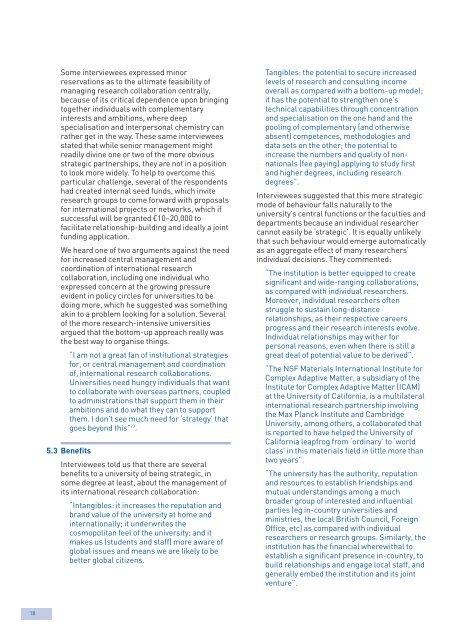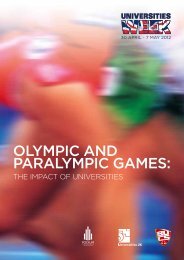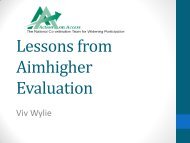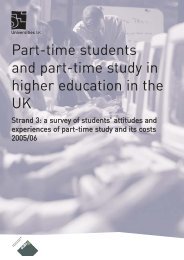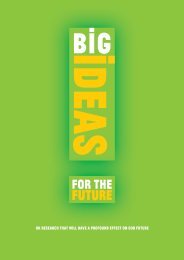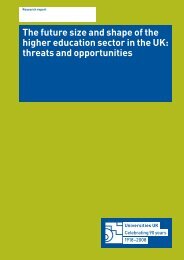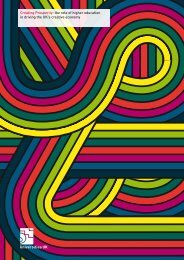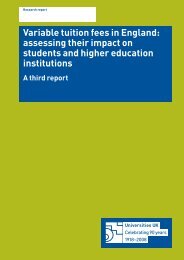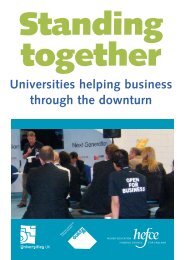International Research Collaboration - GlobalHigherEd
International Research Collaboration - GlobalHigherEd
International Research Collaboration - GlobalHigherEd
Create successful ePaper yourself
Turn your PDF publications into a flip-book with our unique Google optimized e-Paper software.
Some interviewees expressed minorreservations as to the ultimate feasibility ofmanaging research collaboration centrally,because of its critical dependence upon bringingtogether individuals with complementaryinterests and ambitions, where deepspecialisation and interpersonal chemistry canrather get in the way. These same intervieweesstated that while senior management mightreadily divine one or two of the more obviousstrategic partnerships, they are not in a positionto look more widely. To help to overcome thisparticular challenge, several of the respondentshad created internal seed funds, which inviteresearch groups to come forward with proposalsfor international projects or networks, which ifsuccessful will be granted £10–20,000 tofacilitate relationship-building and ideally a jointfunding application.We heard one of two arguments against the needfor increased central management andcoordination of international researchcollaboration, including one individual whoexpressed concern at the growing pressureevident in policy circles for universities to bedoing more, which he suggested was somethingakin to a problem looking for a solution. Severalof the more research-intensive universitiesargued that the bottom-up approach really wasthe best way to organise things.“I am not a great fan of institutional strategiesfor, or central management and coordinationof, international research collaborations.Universities need hungry individuals that wantto collaborate with overseas partners, coupledto administrations that support them in theirambitions and do what they can to supportthem. I don’t see much need for ‘strategy’ thatgoes beyond this” 23 .5.3 BenefitsInterviewees told us that there are severalbenefits to a university of being strategic, insome degree at least, about the management ofits international research collaboration:“Intangibles: it increases the reputation andbrand value of the university at home andinternationally; it underwrites thecosmopolitan feel of the university; and itmakes us (students and staff) more aware ofglobal issues and means we are likely to bebetter global citizens.Tangibles: the potential to secure increasedlevels of research and consulting incomeoverall as compared with a bottom-up model;it has the potential to strengthen one’stechnical capabilities through concentrationand specialisation on the one hand and thepooling of complementary (and otherwiseabsent) competences, methodologies anddata sets on the other; the potential toincrease the numbers and quality of nonnationals(fee paying) applying to study firstand higher degrees, including researchdegrees”.Interviewees suggested that this more strategicmode of behaviour falls naturally to theuniversity’s central functions or the faculties anddepartments because an individual researchercannot easily be ‘strategic’. It is equally unlikelythat such behaviour would emerge automaticallyas an aggregate effect of many researchers’individual decisions. They commented:“The institution is better equipped to createsignificant and wide-ranging collaborations,as compared with individual researchers.Moreover, individual researchers oftenstruggle to sustain long-distancerelationships, as their respective careersprogress and their research interests evolve.Individual relationships may wither forpersonal reasons, even when there is still agreat deal of potential value to be derived”.“The NSF Materials <strong>International</strong> Institute forComplex Adaptive Matter, a subsidiary of theInstitute for Complex Adaptive Matter (ICAM)at the University of California, is a multilateralinternational research partnership involvingthe Max Planck Institute and CambridgeUniversity, among others, a collaborated thatis reported to have helped the University ofCalifornia leapfrog from ‘ordinary’ to ‘worldclass’ in this materials field in little more thantwo years”.“The university has the authority, reputationand resources to establish friendships andmutual understandings among a muchbroader group of interested and influentialparties (eg in-country universities andministries, the local British Council, ForeignOffice, etc) as compared with individualresearchers or research groups. Similarly, theinstitution has the financial wherewithal toestablish a significant presence in-country, tobuild relationships and engage local staff, andgenerally embed the institution and its jointventure”.18


